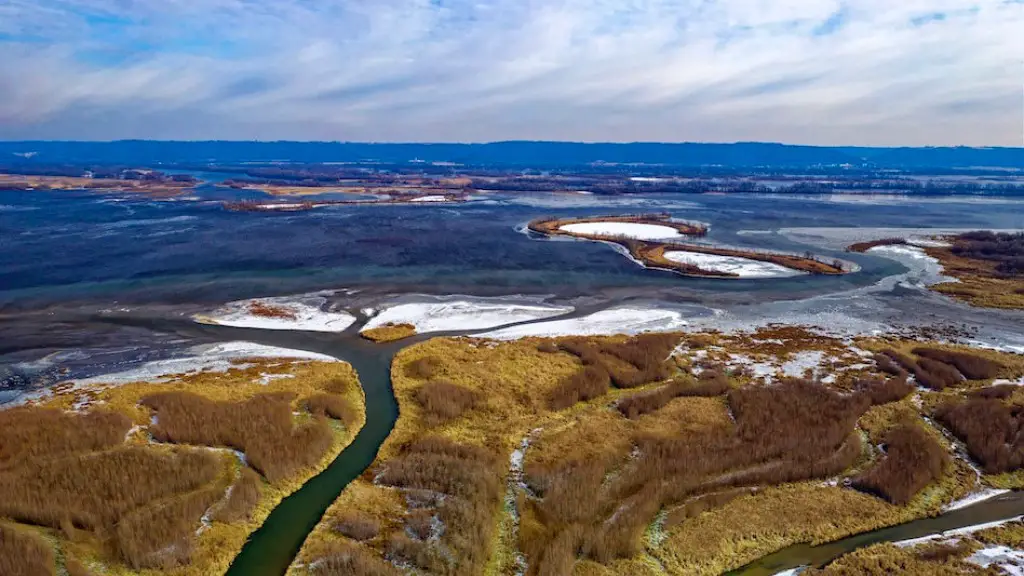History and Location
The Mississippi River is the second-longest river in the United States, winding close to 3,000 miles from its source in Lake Itasca, in Minnesota, to its delta emptying into the Gulf of Mexico in Louisiana. The Mississippi River was the main corridor for commerce, immigration, and culture during America’s westward expansion, helping to shape the growth of the country. Native Americans operated ferry services, ferries and flatboats, used to transport goods and people up and downstream.
Economic Significance
Today, the Mississippi River is the major source of water for agriculture, industry, and transportation in the Midwest and Gulf Coast regions. Agriculture along the Mississippi produces mostly soybeans, grain sorghum, wheat, and corn. Livestock, such as chickens and cows, are also farmed in the region. Hundreds of commercial ships, barges, and tugboats navigate the Mississippi every day. Half of all grain production in the U.S. is transported to Gulf Coast ports, passing through the Mississippi River. The river is also heavily used for recreational activities, notably fishing and boating.
Environmental Changes
The large-scale commercial uses of the Mississippi have led to a number of environmental changes in the river and its surrounding areas. Conservationists point to the effects of overfishing and pollution, which have taken a heavy toll on local wildlife. Runoff from agricultural fields, industrial effluents, and sewage from urban centers have had adverse effects on the health of fish, aquatic birds, and other species that depend on the river for survival.
Conservation Efforts
The Mississippi is a cornerstone of the American natural landscape, but it is facing an array of environmental threats from human activity. To mitigate the effects of pollution, a number of local, state, and federal agencies have pursued conservation efforts. These include enforcing the Clean Water Act, implementing best management practices for farming and industrial operations, and supporting stream and river restoration projects.
Pollution Control
The federal government has also conducted extensive research on non-point source control and pollution prevention, particularly in the areas of sedimentation, erosion control, and stormwater management. These studies, coupled with the implementation of more stringent regulations on industrial facilities, have helped to reduce pollution amounts. Other studies have focused on water quality monitoring and enforcement measures, to identify and respond to emerging issues.
Recreational Opportunities
The Mississippi River is a popular destination for recreational activities, such as boating, fishing, swimming, and camping. Numerous state and local parks offer access to the river for these activities. Tourist and educational centers along the length of the river offer visitors a chance to learn about the history, environment, and culture of the region.
Hydropower Generation
The Mississippi River is also an important source of hydropower. The river’s tremendous velocity creates significant potential for hydropower generation, which helps to meet the region’s energy needs. Hydropower plants have been erected along the length of the river, taking advantage of the steady flow of water.
Regional Water Supply
The Mississippi is also a major source of drinking water for the upper Mississippi basin. The river supplies many communities and cities with clean, freshwater for drinking and other uses. Water from the river is also used to irrigate crop fields, support fish populations, and provide recreational fishing and boating.
Flood Control
Given its immense size, the Mississippi routinely floods during times of heavy rainfall and runoff. To mitigate the effects of annual flooding, numerous levee systems have been erected along the length of the river. These levees act as a buffer, to help keep the river water within reasonable bounds.
Environmental Education
The Mississippi River is a vital resource, and conservationists are pushing the importance of educating people on its importance. In recent years, many school initiatives have been launched to promote a greater understanding of river management and conservation, through curriculum projects and field trips.
Cooperative Conservation
The health of the Mississippi River is a cause of shared concern, and so coalition-building between agencies, private groups, and citizens is important. For example, the Louisiana Environmental Education Partnership creates collaborative projects to better understand and protect the river, such as its role in supporting the commercial fishery along the coast.
Economic Effectiveness
The Mississippi River is a vital economic engine for the Midwest and the Gulf Coast states. The river carries hundreds of commercial ships, barges, and tugboats every day, transporting a variety of goods and resources. Furthermore, the river’s agricultural resources generate important revenue for local farms, and fishing opportunities draw visitors from far and wide.
Science Projects
Educators and environmental groups often develop science projects along the Mississippi River, helping students to better understand its aquatic life, water resources, and local wildlife. These projects often involve the collection of data to track river flow, sediment quality, water temperature, dissolved oxygen levels, and more.
Protecting the River Ecosystem
As the human population continues to grow, so too does the pressure on natural resources. To protect the Mississippi’s fragile ecosystem, conservation efforts stress the importance of responsible development, limiting pollution and runoff, and actively managing its watersheds.
Restoration Efforts
Restoration efforts focus on restoring habitats, aiding wildlife species, and improving the water quality along the river. These efforts include removing invasive species, restoring wetlands, and restoring fish spawning grounds. These efforts are often conducted by governmental agencies, with some help from private or non-profit organizations.



